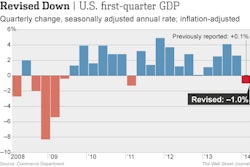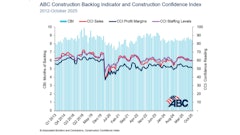Construction employment expanded in 220 metro areas, declined in 70 and was stagnant in 49 between April 2013 and April 2014, according to a new analysis of federal employment data released today by the Associated General Contractors of America. Association officials noted that federal spending cutbacks on government facilities and Hurricane Sandy reconstruction were contributing to job losses around Washington, D.C. and New Jersey.
“Construction employment appears to be rebounding in many parts of the country,” said Ken Simonson, the association's chief economist. “Declines in federal spending likely depressed construction employment near Washington, while of the aftermath of Hurricane Sandy may be having an impact on construction employment in metro areas in New Jersey.”
Los Angeles-Long Beach-Glendale, Calif., added the largest number of construction jobs in the past year (11,100 jobs, 10 percent) followed by:
- Dallas-Plano-Irving, Texas (9,500 jobs, 9 percent)
- Santa Ana-Anaheim-Irvine, Calif. (8,500 jobs, 11 percent)
- Atlanta-Sandy Springs-Marietta, Ga. (8,100 jobs, 9 percent)
The largest percentage gains occurred in:
- El Centro, Calif. (42 percent, 800 jobs)
- Steubenville-Weirton, Ohio-W.V. (35 percent, 600 jobs)
- Pascagoula, Miss. (27 percent, 1,500 jobs)
- Springfield, Ill. (27 percent, 1,000 jobs)
The largest job losses from April 2013 to April 2014 were in Bethesda-Rockville-Frederick, Md., (-3,700 jobs, -11 percent) followed by:
- Gary, Ind. (-2,900 jobs, -15 percent)
- Newark-Union, N.J. (-1,600 jobs, -5 percent)
- Bergen-Hudson-Passaic, N.J. (-1,300 jobs, -5 percent)
The largest percentage decline for the past year was in Atlantic City-Hammonton, N.J., (-18 percent, -900 jobs) followed by:
- Gary, Ind.; Danville, Ill. (-13 percent, -100 jobs)
- Vineland-Millville-Bridgeton, N.J. (-13 percent, -300 jobs)
El Centro, Calif., experienced the largest percentage increase (23 percent, 500 jobs higher than April 1991) among the 22 metro areas that topped or matched their prior April construction employment highs. Baton Rouge, La., added the most jobs since reaching its prior April peak in 2013 (4,100 jobs, 9 percent). Phoenix-Mesa-Glendale, Ariz., (-89,100 jobs, -49 percent) experienced the largest drop in total construction employment compared to its prior April peak in 2006 while Lake Havasu City-Kingman, Ariz., experienced the largest percentage decline compared to its April 2006 peak (-68 percent, -5,300 jobs).
Association officials noted signs that the federal government is again ready to invest in aging infrastructure should provide more stability for a construction industry that has yet to fully recover from its years-long downturn. Last week the Water Resources Reform & Development Act, which provides funding for vital waterways, port and flood control projects, passed the House and Senate with overwhelming bipartisan support. And a Senate committee recently backed new surface transportation legislation to fund highway, bridge and transit improvements.
“After years of declining public sector demand for construction that has partly offset growing private sector demand, Washington officials seem open to investing in our aging infrastructure,” said Stephen E. Sandherr, the association’s chief executive officer. “Passing a new highway and transportation bill would certainly help boost construction employment in many parts of the country.”



















